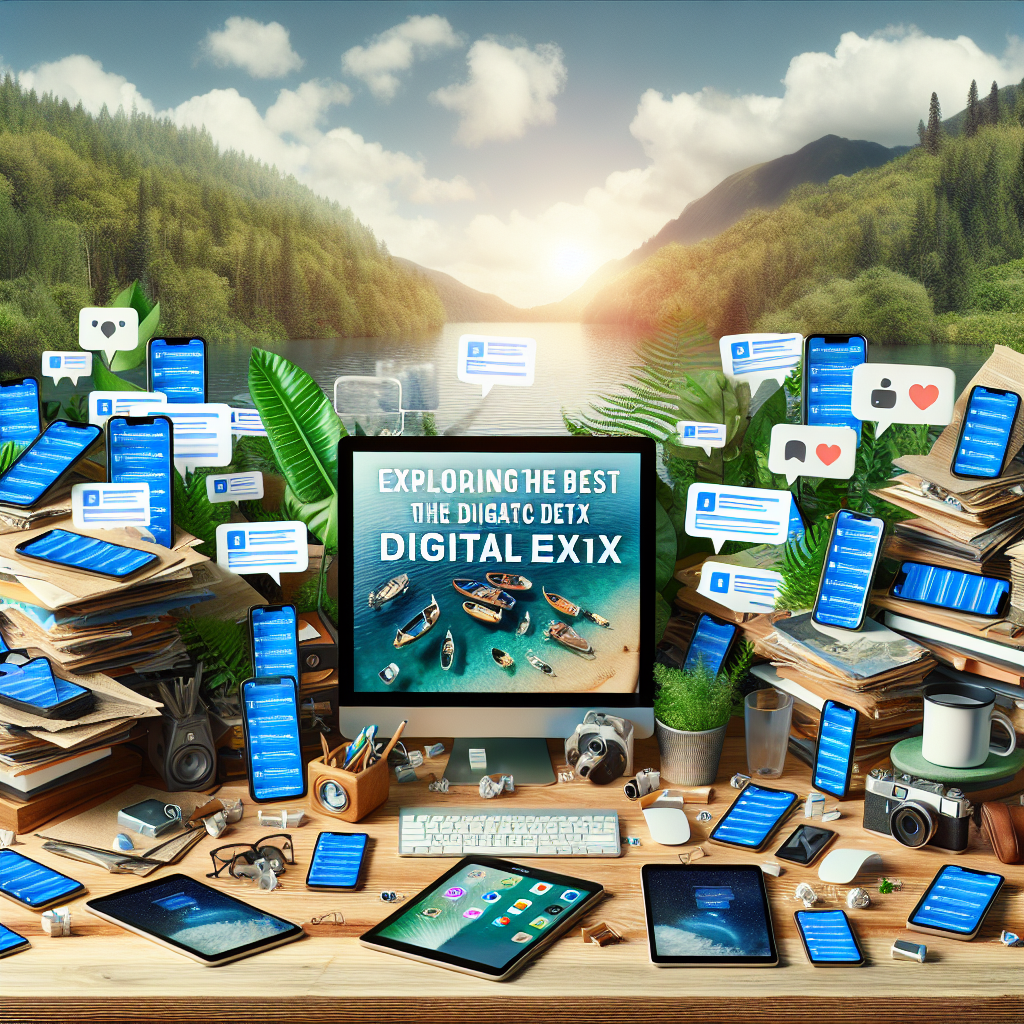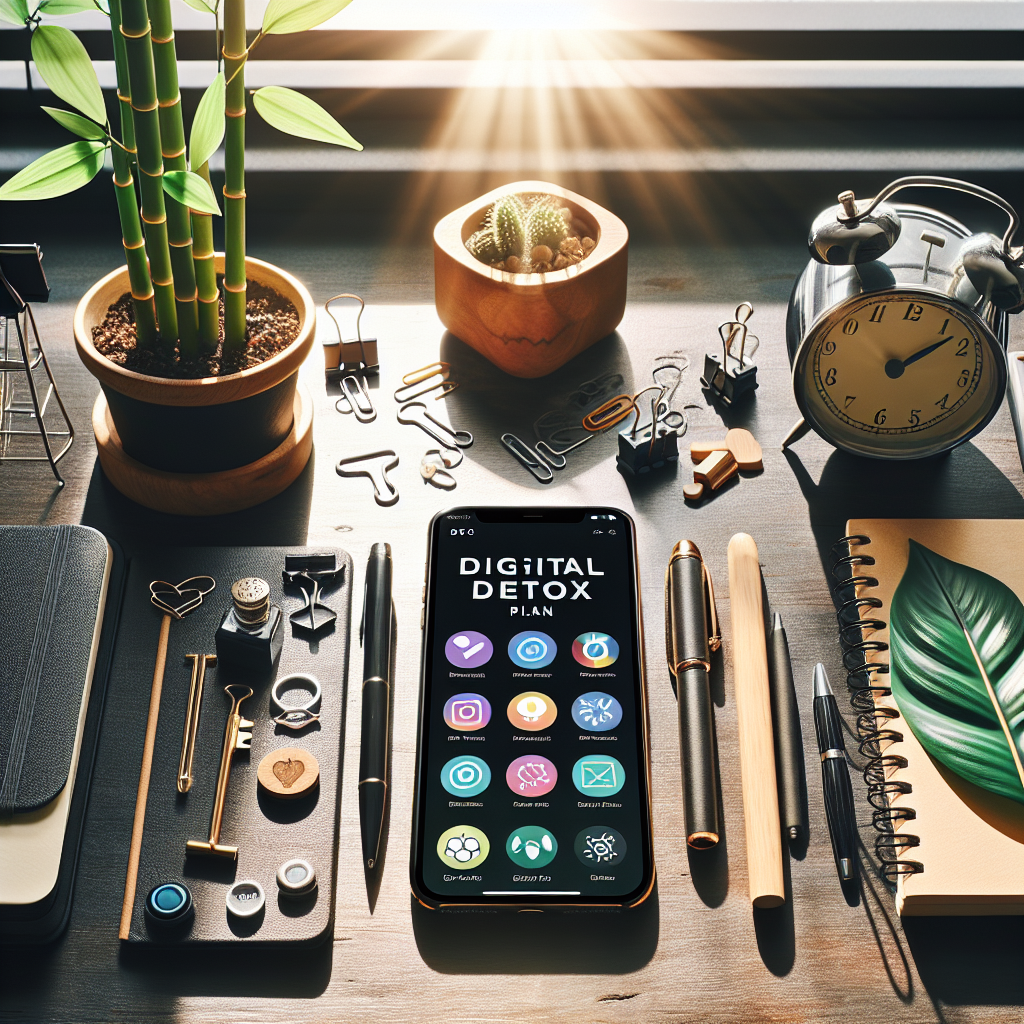In a world consumed by screens and constant connectivity, finding moments of digital detox is essential for our mental well-being. Technology has given rise to a new wave of tools and apps designed to help us disconnect and reclaim our time away from the digital noise. From digital detox trackers and screen time limiters to mindfulness meditation apps and productivity planners, the options are endless. In this comprehensive guide, we will delve into the best digital detox tools and apps available, exploring their features, benefits, and how they can help you strike a healthy balance between technology and real life.
Understanding Digital Detox

In today’s fast-paced digital age, the concept of digital detox has gained significant attention as individuals seek ways to reduce screen time and disconnect from technology. Understanding digital detox involves delving into its definition, recognizing its importance in contemporary society, and addressing common misconceptions surrounding the practice.
Defining Digital Detox
- Digital detox refers to the intentional period during which individuals refrain from using electronic devices such as smartphones, computers, and tablets.
- It involves limiting screen time, avoiding social media platforms, and focusing on real-world interactions and activities.
- The goal of digital detox is to reduce dependency on technology, alleviate stress caused by constant connectivity, and promote mindfulness and well-being.
Importance of Digital Detox in Today’s Society
- In today’s society, where technology is omnipresent, digital detox plays a crucial role in maintaining a healthy balance between the virtual and physical worlds.
- Excessive screen time has been linked to various negative effects, including eye strain, sleep disturbances, decreased productivity, and heightened stress levels.
- Engaging in regular digital detox sessions can help individuals recharge, improve mental clarity, foster deeper connections with others, and enhance overall quality of life.
Common Misconceptions about Digital Detox
- One common misconception is that digital detox is only necessary for individuals with severe technology addiction. In reality, anyone can benefit from periodic disconnection.
- Another misconception is that digital detox requires completely cutting off all technology use. In truth, it can be tailored to individual preferences and needs, allowing for a gradual reduction in screen time.
- Some may believe that digital detox is a temporary solution rather than a sustainable lifestyle change. However, incorporating regular detox practices can lead to long-term positive habits and improved well-being.
Benefits of Digital Detox Tools and Apps
Digital detox tools and apps offer a multitude of benefits that can significantly impact individuals’ daily lives and well-being. Here are the key advantages:
Increased Productivity and Focus
Digital detox tools and apps provide a structured approach to limiting distractions from electronic devices, allowing users to focus more effectively on tasks at hand. By reducing the constant interruptions from notifications and social media, individuals can enhance their productivity levels and accomplish goals more efficiently. This increased focus can lead to a sense of achievement and satisfaction in completing tasks without the constant urge to check devices.
Improved Mental Health and Well-being
Engaging in digital detox activities through various tools and apps can have a positive impact on mental health. Constant exposure to screens and online content can contribute to feelings of anxiety, stress, and overwhelm. By taking breaks and disconnecting from digital devices, individuals can experience reduced levels of anxiety, improved mood, and a sense of calmness. This break from digital stimuli allows for mental clarity and the opportunity to engage in mindfulness practices, promoting overall well-being.
Enhanced Relationships and Social Connections
Digital detox tools and apps encourage users to step away from their screens and engage more fully in real-life interactions. By setting boundaries around digital usage, individuals can dedicate quality time to connecting with family and friends, fostering deeper relationships and meaningful conversations. This intentional focus on interpersonal connections can lead to increased empathy, understanding, and overall satisfaction in personal relationships. Additionally, reducing screen time allows for more face-to-face interactions, which can strengthen social bonds and create lasting memories.
Productivity Tools
In the realm of digital detox, productivity tools play a crucial role in helping individuals manage their time effectively and limit distractions. The following are some of the most effective productivity tools that can aid in achieving a digital detox:
- Pomodoro Technique: The Pomodoro Technique is a time management method developed by Francesco Cirillo in the late 1980s. It involves breaking work into intervals, traditionally 25 minutes in length, separated by short breaks. This technique is designed to enhance focus and productivity by encouraging individuals to work in short, concentrated bursts.
- Forest App: The Forest App is a unique productivity tool that helps users stay focused and present by gamifying the process of avoiding distractions. Users plant virtual trees that grow in the app as long as they resist the temptation to use their phones. This visual representation of focus can be incredibly motivating and rewarding.
- Freedom: Freedom is a powerful app that enables users to block distracting websites and apps across their devices. By creating custom blocklists and scheduling focused sessions, Freedom empowers individuals to eliminate digital distractions and reclaim their time for more meaningful activities. This tool is particularly useful for those looking to cultivate a more intentional and mindful relationship with technology.
Mindfulness Apps
In the realm of digital detox tools and apps, mindfulness apps have gained significant popularity for their ability to help individuals disconnect from the constant stream of digital information and cultivate a sense of presence and awareness. These apps offer a variety of features aimed at promoting relaxation, reducing stress, and improving overall well-being. Here are some of the top mindfulness apps that can aid in your digital detox journey:
- Headspace: Known for its guided meditation sessions, Headspace offers a structured approach to mindfulness practice. With a wide range of themed meditation sessions, users can choose from options like stress relief, sleep, focus, and more. The app also provides progress tracking and personalized recommendations based on individual goals and preferences.
- Calm: Calm is another popular mindfulness app that offers guided meditations, soothing music, sleep stories, and breathing exercises. With a focus on relaxation and stress reduction, Calm provides users with a toolkit for managing anxiety and enhancing mental clarity. The app’s serene interface and diverse content make it a versatile companion for digital detox efforts.
- Insight Timer: Insight Timer stands out for its extensive library of guided meditations led by experienced teachers and mindfulness experts. In addition to meditation sessions, the app features talks, music tracks, and community groups for users to connect with like-minded individuals. Insight Timer’s customizable timer and progress insights cater to both beginners and seasoned practitioners looking to deepen their mindfulness practice.

How to Choose the Right Digital Detox Tool
When embarking on the journey of selecting a digital detox tool, it is crucial to consider various factors to ensure it aligns with your needs and goals effectively.
Identifying Personal Needs and Goals
Understanding your digital habits: Before choosing a digital detox tool, take the time to reflect on your digital habits. Identify which aspects of technology are consuming most of your time and causing distractions in your daily life.
Setting clear objectives: Define what you aim to achieve by implementing a digital detox. Whether it’s reducing screen time, improving productivity, or enhancing mental well-being, having clear goals will guide you in selecting the right tool.
Considering specific preferences: Take into account your preferred detox approach. Some individuals may benefit from a complete break from technology, while others may seek moderation and balanced usage. Understanding your preferences will help in choosing a tool that resonates with your desired detox method.
Considering User-Friendly Interfaces
Ease of use: Look for digital detox tools with intuitive interfaces that are easy to navigate. Complicated apps or tools may deter you from using them consistently, hindering the effectiveness of your detox efforts.
Accessibility across devices: Ensure that the detox tool you choose is accessible across various devices you use regularly. Whether it’s a smartphone, tablet, or computer, seamless integration will encourage consistent usage and monitoring of your digital habits.
Customization options: Opt for tools that offer customization features to tailor the detox experience to your specific needs. The ability to set personalized goals, reminders, and restrictions can enhance the effectiveness of the tool in helping you achieve your detox objectives.
Reading Reviews and Recommendations
Seeking user feedback: Before finalizing your decision on a digital detox tool, explore reviews and testimonials from other users. Pay attention to both positive and negative feedback to gain insights into the tool’s strengths and limitations.
Expert recommendations: Consider seeking recommendations from digital wellness experts or professionals in the field. Their insights and expertise can guide you towards tools that are reputable, effective, and aligned with best practices in digital detoxification.
Trial periods and demos: Whenever possible, opt for tools that offer trial periods or demos. Testing the tool firsthand will give you a practical understanding of its features, functionality, and compatibility with your digital detox goals before committing to long-term usage.
Incorporating Digital Detox into Daily Routine
In today’s digitally-driven world, incorporating digital detox into daily routines has become essential for maintaining overall well-being and mental health. Here are some key strategies to effectively integrate digital detox practices into your daily life:
- Setting Realistic Goals and Boundaries
- Begin by setting realistic goals for your digital detox journey. Identify areas of your life where you feel most overwhelmed by technology and establish boundaries around them. This could include limiting screen time before bed, during meals, or during social interactions.
- Establish clear guidelines for yourself on when and how you will engage with digital devices. Setting boundaries will help you create a healthier relationship with technology and prevent digital burnout.
- Creating a Digital Detox Plan
- Develop a structured digital detox plan that outlines specific times and activities during which you will disconnect from screens. This could involve scheduling regular breaks throughout the day to engage in offline activities such as reading, exercising, or spending time in nature.
- Consider creating a physical calendar or digital reminder to prompt you to take breaks from technology. Having a concrete plan in place will make it easier to stick to your digital detox goals and build healthier habits over time.
- Implementing Small Changes for Long-Term Success
- Start small by making incremental changes to your daily routine that gradually reduce your reliance on digital devices. This could involve turning off notifications, deleting distracting apps, or designating tech-free zones in your home.
- Focus on incorporating activities that bring you joy and fulfillment outside of the digital realm. Engage in hobbies, connect with loved ones face-to-face, or practice mindfulness to cultivate a sense of balance and presence in your daily life.
By setting realistic goals, creating a structured digital detox plan, and making small changes to your routine, you can successfully incorporate digital detox practices into your daily life and reap the benefits of reduced screen time and increased well-being.
Tips for a Successful Digital Detox
Incorporating a digital detox into your daily routine can greatly benefit your mental and physical well-being. Here are some practical tips to ensure a successful digital detox experience:
- Designating Tech-Free Zones: Establish specific areas in your home or workspace where electronic devices are not allowed. This could be your bedroom, dining area, or a designated relaxation spot. By creating these tech-free zones, you can disconnect from screens and focus on being present in the moment.
- Engaging in Offline Activities: Fill your time with activities that do not involve digital devices. This could include reading physical books, going for a nature walk, practicing a hobby like painting or gardening, or engaging in face-to-face conversations with friends and family. By immersing yourself in offline activities, you can reduce screen time and reconnect with the real world.

– Practicing Mindful Technology Use: Be conscious of how and why you are using technology. Set specific boundaries for when and how long you will use digital devices each day. Practice mindfulness by taking breaks from screens, practicing deep breathing exercises, or simply observing your surroundings without distractions. By being mindful of your technology usage, you can develop a healthier relationship with digital devices and avoid constant connectivity.
Tracking Progress and Staying Accountable
In the realm of digital detox, tracking progress and staying accountable are crucial components for maintaining a healthy balance between technology use and real-life experiences. Utilizing various methods can help individuals monitor their habits and ensure they are making meaningful changes towards reducing screen time and enhancing overall well-being.
- Journaling Daily Experiences: One effective way to track progress during a digital detox is through journaling daily experiences. By reflecting on thoughts, emotions, and activities in a tangible format, individuals can gain insight into how technology impacts their lives. Journaling allows for self-reflection and serves as a tool to identify patterns of behavior related to digital consumption. Writing down observations can help individuals stay accountable and motivated to continue their detox journey.
- Using Habit-Tracking Apps: Technology can also be leveraged to support digital detox efforts through the use of habit-tracking apps. These applications allow users to set specific goals for reducing screen time, tracking usage patterns, and receiving reminders to take breaks from devices. By monitoring progress in real-time and visualizing data on screen time, individuals can gain a better understanding of their digital habits and make informed decisions about limiting technology use. Habit-tracking apps provide a structured approach to staying accountable and fostering healthier relationships with technology.
- Seeking Support from Friends or Family Members: Another strategy for tracking progress and staying accountable during a digital detox is to seek support from friends or family members. By sharing goals and challenges with trusted individuals, individuals can create a network of accountability partners who can offer encouragement, guidance, and motivation. Engaging in open conversations about digital habits and setting collective goals can strengthen the commitment to unplugging and prioritizing offline activities. Connecting with others who understand the importance of digital detox can provide a sense of community and shared responsibility in maintaining a balanced lifestyle.
FAQs Exploring the Best Digital Detox Tools and Apps: A Comprehensive Guide
What are digital detox tools and apps?
Digital detox tools and apps are applications or devices designed to help users reduce screen time, disconnect from technology, and foster a healthier relationship with digital devices. These tools often offer features such as screen time tracking, app blocking, and mindfulness exercises to promote a more balanced lifestyle.
How can digital detox tools and apps benefit me?
Digital detox tools and apps can help improve mental well-being by reducing stress and anxiety associated with excessive screen time. They can also promote better sleep patterns, increase productivity, and enhance personal relationships by encouraging more face-to-face interactions. Ultimately, using these tools can lead to a more mindful and intentional use of technology.
What are some popular digital detox tools and apps available in the market?
Some popular digital detox tools and apps include Forest, Offtime, Freedom, and Moment. Forest uses gamification to help users stay focused on their tasks by planting virtual trees, while Offtime allows users to block distracting apps and notifications. Freedom provides website and app blocking services, and Moment tracks screen time usage and offers reminders to take breaks from devices.
Can I use digital detox tools and apps on all devices?
Most digital detox tools and apps are compatible with both Android and iOS devices, and some may also have desktop versions for Windows and Mac computers. Before downloading a digital detox tool, make sure to check its compatibility with your specific devices to ensure optimal functionality.
How do I get started with a digital detox tool or app?
To get started with a digital detox tool or app, simply download it from the app store or website and follow the instructions for setting up your preferences. You can customize your settings to block specific apps or websites, set screen time limits, and schedule break times. It’s important to commit to using the tool consistently to see the benefits of reducing your digital dependency.